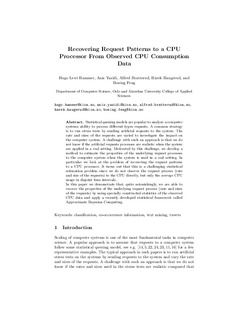Recovering Request Patterns to a CPU Processor from Observed CPU Consumption Data
Chapter
Accepted version
Permanent lenke
http://hdl.handle.net/11250/2428644Utgivelsesdato
2016Metadata
Vis full innførselSamlinger
Originalversjon
Industrial Networks and Intelligent Systems. Lecture Notes of the Institute for Computer Sciences, Social Informatics and Telecommunications Engineering, vol 188. Springer, Cham 10.1007/978-3-319-52569-3_2Sammendrag
Statistical queuing models are popular to analyze a computer systems ability to process different types requests. A common strategy is to run stress tests by sending artificial requests to the system. The rate and sizes of the requests are varied to investigate the impact on the computer system. A challenge with such an approach is that we do not know if the artificial requests processes are realistic when the system are applied in a real setting. Motivated by this challenge, we develop a method to estimate the properties of the underlying request processes to the computer system when the system is used in a real setting. In particular we look at the problem of recovering the request patterns to a CPU processor. It turns out that this is a challenging statistical estimation problem since we do not observe the request process (rate and size of the requests) to the CPU directly, but only the average CPU usage in disjoint time intervals.
In this paper we demonstrate that, quite astonishingly, we are able to recover the properties of the underlying request process (rate and sizes of the requests) by using specially constructed statistics of the observed CPU data and apply a recently developed statistical framework called Approximate Bayesian Computing.
